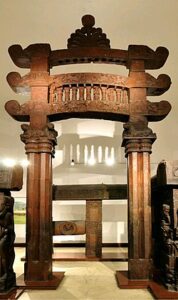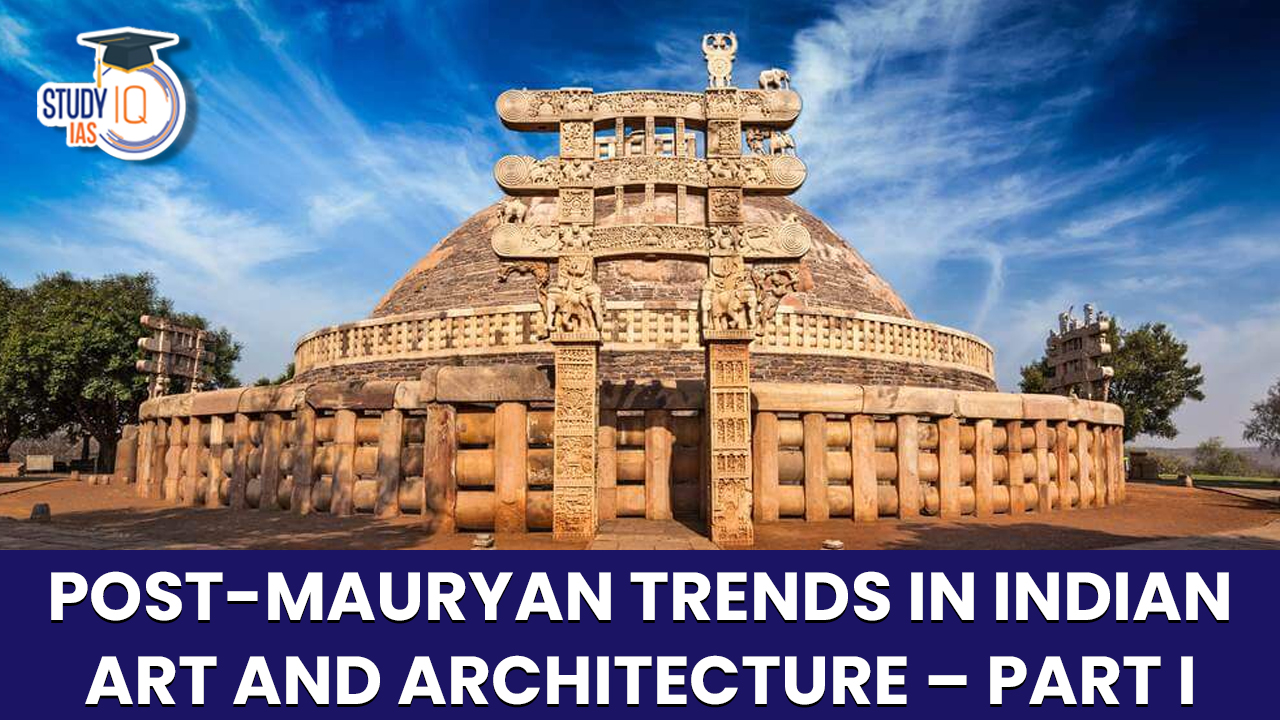Table of Contents
Post-Mauryan Trends in Indian Art and Architecture – Part I
Following the collapse of the Mauryan Empire in the second century BC, different dynasties took control of the areas that had previously been ruled by the Mauryas, including the Satavahanas, Abhiras, Ikshvakus, and Vakatakas in the south and western India, and the Shungas, Kanvas, Kushanas, and Guptas in the north and centre. Brahmanical sects like the Shaivas and the Vaishnavas also came into existence at this time.
In addition to Bharhut and Vidisha in Madhya Pradesh, Mathura in Uttar Pradesh, Bodhgaya in Bihar, Jaggayyapeta in Andhra Pradesh, Bhaja and Pavani in Maharashtra, and Khandagiri and Udaigiri in Odisha also include notable examples of excellent sculpture.
Post Mauryan Art and Architecture
From the second century BCE forward, a number of kings established their dominion over the enormous Mauryan Empire: the Satavahanas, Ikshavakus, Abhiras, and Vatakas in southern and western India; the Shungas, Kanvas, Kushanas, and Guptas in the north and parts of central India. The main Brahmanical sects, including the Vaishnavas and Shaivas, also saw a growth during this time..
Post-Mauryan Trends in Indian Art and Architecture – Part I: Barhut
Similar to the Yaksha and Yakshini statues from the Mauryan era, Barhut sculptures are tall. Low relief modelling is used to ensure linearity in the sculpture’s volume. tales are used to show relief panels, and the intelligibility of the tales is improved by choosing key moments. Initially, there are fewer people in narrative panels, but as time goes on, individuals other than the main character of the story have begun to appear in the image area.

The sculptors make the best possible use of the available space. The artistic use of the pictorial language to convey stories is demonstrated by the narrative reliefs at Barhut. One of these stories depicts the dream of Siddhartha Gautama’s mother, Queen Mahamaya/Mayadevi. While an elephant is depicted on the top of the bed, moving towards Queen Mayadevi’s womb, the monarch is reclining on the bed.
The presentation of a Jataka story, however, is quite straightforward and is narrated by grouping the events according to the story’s setting, like in the case of the Ruru Jataka, in which a Bodhisattva deer saves a man by carrying him on his back. Such Jataka tales were included into stupa ornamentation. Regional style differences also started to appear with the increase in stupa construction around the nation.
Post-Mauryan Trends in Indian Art and Architecture – Part I: Sanchi
In Andhra Pradesh, the Sanchi stupa-1, Mathura, and Vengi sites represent the next stage of cultural evolution. Both an upper and a lower pradakshinaptha, or circumambulatory path, exist on Stupa-1 in Sanchi. It contains four exquisitely decorated Torans (Gateways), each of which portrays a different Jataka story and an incident from Buddha’s life. High relief figure compositions occupy the entire frame.

There is no rigidity in the body, and the posture is depicted in an organic manner. More detail is added to the narration, and carving methods surpass those of Barhut. The representation of Buddhas or previous Buddhas through symbols has persisted (the textual tradition lists 24 Buddhas, but only the first, Dipankar, and the final six are depicted visually). The presentation of the dream sequences (the dream of Queen Mayadevi) remains incredibly straightforward despite the plot becoming more complex.
Stupa-1, Sanchi (Madhya Pradesh):
A World Heritage Site in Madhya Pradesh is Sanchi, which is close to Bhopal. There are three large stupas and a few additional smaller ones. It is said that Stupa-1 contains the Buddha’s relics. The remains of eleven lesser-known Arhats from three different generations can be found in Stupa-2. (An Arhat is a perfected person who has gained Nirvana in Theravada Buddhism. People who have made significant progress on the path of enlightenment but have not yet fully attained Buddhahood are referred to by this word in different Buddhist traditions.

Sariputta and Mahamoggallana/Mahamougalayana (disciples of Gautama Buddha) remains can be found at Stupa-3. The carvings on Stupa-1’s torans are what make it the best example of stupa building. It started out as a tiny brick building that gradually became larger and was covered in stone, vedika (fence), and Torans. Additionally, this location features an upper pradakshinapatha, making a total of two pradakshinapathas.
Buddha is metaphorically represented by things like an empty throne, feet, chhatras, stupas, etc. All four directions are used in toran construction. Their stylistic differences suggest that they were created starting in the first century BCE. Even though stupa-1 is the earliest stupa, stupa-2’s vedika has picture carvings that predate those on stupa-1. Jataka tales also rose to prominence in the storytelling.
Sanchi’s figures are extremely realistic despite their small size. There are guardian figures on the sculptors, and the magnitude of the salabhanjika sculptures (which are sculptures of women holding plates or tree branches) is impressive. Each torana has three horizontal bars on top and two vertical pillars. Each horizontal bar is embellished on both sides with various sculptural ideas. The images of Salabhanjikas are supporting the extension of the lowest horizontal bar from below.
Post-Mauryan Trends in Indian Art and Architecture – Part I: Early temples
Along with stupas, Brahmanical temples also began to appear. Temples were embellished with depictions of the Purana mythology as well as divine figures. Every temple has a central representation of a deity. The temples had three different types of shrines:
- Sandhara type: without pradakshinapatha (circumambulatory path)
- Nirandhara type: with pradakshinapatha
- Sarvatobhadra: which can be accessed from all sides
Important temple sites from this period: Deogarh (UP); Eran, Udaygiri, Nachna-Kuthara (near Vidisha in MP). These are simple structures with a veranda, a hall and the shrine at the back.
Buddhist Monuments of South India
The Vengi region in Andhra Pradesh has many stupas, in Jaggayyapeta, Amaravati, Nagarjunakonda, Bhattiprolu, Goli, etc.
Amaravati School of Art
It was created in the Satavahana era. Since things from here were exported to Sri Lanka and south-east Asia, this is completely indigenous in nature and has had a significant impact on the art in those regions. had a Mahachaitya and several sculptures. The sculptures are kept in the British Museum in London, the Amaravati Site Museum, the National Museum in Delhi, and the Chennai Museum.
The Pradakshinapatha and Vedica (fence) of the Amaravati Stupa are decorated with numerous sculptures. The torana (gateway) is no longer there. The dome of this stupa is covered in slabs of relief stupa sculpture, which is a distinctive feature. Both Jataka stories and events from Buddha’s life are depicted. It was initially constructed in the first century AD and afterwards developed or improved.
Buddha images are not visible in the initial phase, but they become visible in the latter phases (like the stupa in Sanchi). Strong emotions can be seen in the sculptures. The figures have a lot of movement and are lean. The body are depicted with three bents, or trihanga. Compared to Sanchi, the buildings are more sophisticated and animated. The legibility of the forms is given a lot of consideration.
The sculptures of Goli and Nagarjunakonda from the third century are still exceedingly three-dimensional but have less liveliness. In Amaravati, Nagarjunakonda, and Guntapalle, there are independent Buddha statues. Guntappale: Near Elluru, a rock-cut cave location. Anakapalle, which is close to Vishakhapatnam, and Sannati, the largest in Karnataka, are two more locations with rock-cut stupas. Images of Boddhisattvas such as Avalokiteshvara, Vajrapani, Padmapani, Amitabha, and Maitreya Buddha are also seen in addition to Buddha images.


 UPSC CMS Admit Card 2025 Out: Download L...
UPSC CMS Admit Card 2025 Out: Download L...
 UPSC Study Material for Prelims & Ma...
UPSC Study Material for Prelims & Ma...
 Story of Meera Bai and Her Devotion For ...
Story of Meera Bai and Her Devotion For ...





















